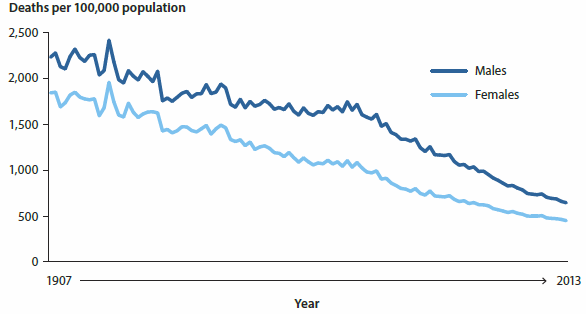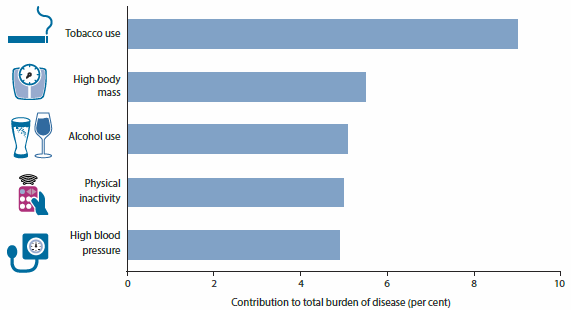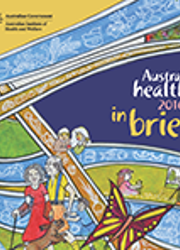Doing well, but could do better
There is plenty of good health news in Australia—overall death rates, cancer deaths and smoking rates continue to fall.
Despite this, there are still some big concerns facing us as individuals and as a nation, and one of the biggest is chronic disease. Australians continue to put themselves at risk of developing lifestyle-related chronic illnesses that are generally associated with risk factors that we can do something about. These risk factors include smoking, physical inactivity, poor nutrition and the harmful use of alcohol.
Death rates continue to fall
Despite an increase in the absolute number of deaths, there has been a long and continuing fall in death rates in Australia. From 1907 to 2013, the age-standardised death rates for males and females fell by 71% and 76% respectively. Between 2003 and 2013, the death rate fell by 20% for males and 15% for females and, between 2012 and 2013, by 2% for males and 3% for females.
Age-standardised death rates by sex, Australia, 1907-2013

Cancer is increasing, but so is survival
Between 1982 and 2016, the age-standardised incidence of cancer increased, from an estimated 383 cases per 100,000 population to 467 per 100,000 (an increase of 22%).
While the number of new cancer cases increases each year, more people are surviving having cancer. The age-standardised mortality rate—for all types of cancer combined—fell by 22%, from 209 deaths per 100,000 population in 1982 to 162 deaths per 100,000 population in 2016.
From 1982-1986 to 2007-2011, 5-year relative survival improved from 40% to 66% for males and from 52% to 68% for females for all cancers combined. ('Relative survival' is a measure of the average survival experience of people with cancer, compared with their counterparts in the general population.) Among people who had already survived 5 years past their cancer diagnosis, the chance of surviving for at least another 5 years was 91%.
Australia has the second-highest incidence rate of cancer out of the 34 OECD countries, partly reflecting our screening success. However, for deaths from cancer, we rank in the middle third.
Heart disease deaths are down, but still our leading single cause of death
Coronary heart disease (CHD) occurs more commonly in males than in females, and is also more common in older age groups. Many cases are preventable, as a number of its risk factors are modifiable, including tobacco smoking, high blood cholesterol, high blood pressure, physical inactivity, poor nutrition and obesity.
Even though death rates have fallen by 75% over the 3 decades from 1983 to 2013 (largely due to reductions in key risk factors such as smoking, and improvements in medical and surgical treatments), CHD is still the leading single cause of death in Australia (accounting for 13% of all deaths in 2013).
While Australia's CHD death rates have fallen substantially over the last 3 decades, more than half of OECD countries have lower rates than Australia—we rank 19th among 34 OECD countries.
Nearly half of us will experience a mental disorder
Around 45% of Australians aged 16-85 will experience a common mental disorder such as depression, anxiety or a substance use disorder in their lifetime while 20% had a mental health disorder at some time during the 12 months prior to the 2007 National Survey of Mental Health and Wellbeing.
Mental illness is a large burden for young Australians. In 2013-14, 14% (560,000) of children and young people aged 4-17 had a mental disorder in the preceding 12 months. Attention deficit hyperactivity disorder was the most commonly experienced mental disorder, affecting 7.4% of all children and youth in the preceding 12 months. Anxiety disorders were the next most common (6.9%), followed by major depressive disorder (2.8%) and conduct disorder (2.1%). (Note, children and young people may have had more than one class of mental disorder, therefore, the sum of disorders is higher than 14%.)
Mental disorders among young people aged 12-17

1 in 7 people will have suicidal thoughts
At some point in their lives, 13.3% of Australians aged 16-85 have experienced suicidal thoughts and 3.3% have attempted suicide. From 2004 to 2013, an average of 2,300 Australians died by suicide each year.
Suicide is the leading cause of death for young Australians aged 15-24. In 2013, there were 10 suicide deaths per 100,000 people for the 15-19 age group and 12 deaths per 100,000 people for the 20-24 age group. Rates have been relatively stable over the last 15 years.
In 2013, the rate for Indigenous Australians who died by intentional self-harm or suicide was more than double the rate for non-Indigenous Australians (23.8 and 10.8 per 100,000 people, respectively).
Services available for people at risk of suicide/intentional self-harm are:

More than 1 million Australians have diabetes
An estimated 1.2 million Australians (5.1%) had diabetes in 2014-15, most of whom (85%) had type 2 diabetes. Type 2 diabetes is largely preventable: risk factors that can lead to type 2 diabetes include insufficient physical activity; saturated fat intake; obesity; and tobacco smoking.
Diabetes is more common in males (6%) than in females (4%), and increases with age (to about 16% for those aged 65-74).
More than 2 in 3 people (68%) with diabetes also had cardiovascular disease and/or chronic kidney disease in 2011-12.
In 2013, diabetes contributed to 10% of all deaths in Australia (15,100 deaths)—although in most (71%) of these it was recorded as an associated, rather than the underlying, cause of death. Diabetes death rates remained relatively stable between 1997 and 2013, with age-standardised rates between 53 and 62 deaths per 100,000 population each year.
We are putting ourselves at risk
Factors that influence the chance of ill health, disability, disease or death are known as 'risk factors'.
Some risk factors are classified as 'modifiable' because they can be eliminated or reduced through behavioural or environmental changes.
In 2011, a large proportion (31%) of the burden of disease experienced by the Australian population could have been prevented by reducing modifiable risk factors such as tobacco use, high body mass, alcohol use, physical inactivity and high blood pressure.
Proportion of total burden attributable to the five risk factors causing the most burden, Australia, 2011

But are we changing?
Today, we are less likely to smoke daily and drink at lifetime risky levels than in the past.
In 2013, the proportion of people aged 14 and over smoking daily (13%) was lower than in 2010 (15%), and almost half that in 1991 (24%).
Between 2010 and 2013, daily drinking and lifetime risky drinking (more than 2 standard drinks per day on average) declined for people aged 14 and over.
However, a considerable proportion of people continue to drink in excess (that is, very risky drinkers)—in 2013, 16% of people aged 12 and over had consumed 11 or more standard drinks on a single drinking occasion in the past 12 months (compared with 17% in 2010).
Australia has had declining smoking rates over many years and is doing well internationally: we have the fourth-lowest smoking rate among 34 OECD countries.
While daily and lifetime risky drinking is falling, Australians still consume a higher number of litres of alcohol, per person, annually, than the OECD average (9.9 and 8.8 respectively)—we are in the middle third among 34 OECD countries.
Saying 'no' to alcohol and tobacco
The proportion of people aged 14 and over who reported never smoking rose from 58% in 2010 to 60% in 2013. While just over 1 in 10 (11%) young people aged 15-24 were current, daily smokers in 2013, the majority (81%) had never smoked.
The proportion of people abstaining from drinking alcohol rose from 20% in 2010 to 22% in 2013.
In 2013, over one-quarter (27%) of young people had never drunk alcohol—an increase from 16% in 2001.
While the proportion of people who drank daily increased with age, in 2013, over 20% of people aged 85 and over had never drunk alcohol.
Little movement on exercise, weight and diet
In 2014-15, almost half (45%) of adults aged 18-64 were inactive or insufficiently active for health benefits, which was similar to the proportion in 2011-12.
In 2014-15:
- the vast majority (97%) of children aged 5-14 did not eat the recommended daily serves of vegetables, while almost a third (30%) did not eat the recommended daily serves of fruit.
- the vast majority of adults did not eat the recommended 5 daily serves of vegetables (93%) and half (50%) did not eat the recommended 2 daily serves of fruit. These rates were similar to 2011-12
The proportion of overweight or obese adults increased from 56% to 63% between 1995 and 2014-15—an average increase of 4.4 kg for both men and women. Of the estimated 11.2 million adults who were overweight or obese in 2014-15, 4.9 million were obese.
In 2014-15, just over 1 in 4 (26% or 750,000) children aged 5-14, and nearly 4 in 10 (37% or 1.1 million) young people aged 15-24 were overweight or obese.
Australia has the fifth-highest rate of obesity for people aged 15 and over (or 30th among 34 OECD countries), with rates almost 1.5 times as high as the OECD average.



